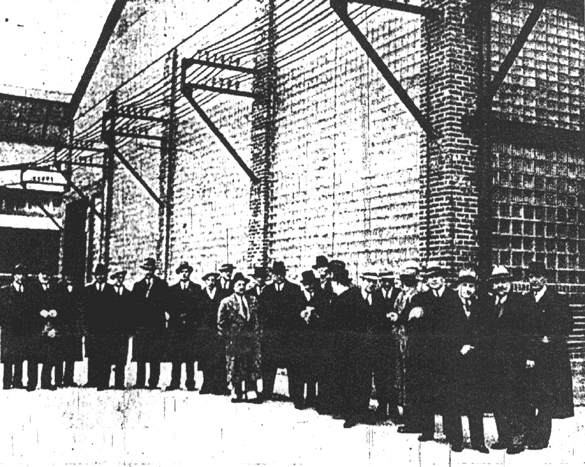[Newspaper]
Publication: The Muncie Morning Star
Muncie, IN, United States
vol. 60, no. 338, p. 1, col. 4-7
Glass Bricks Withstand Gruelling Fire
And Water Test at Owens-Illinois Plant
|
In the above group are the men who saw Insulux, glass building block of the Owens-Illinois Company, tested by fire and water at the company's Macedonia avenue plant.
From left to right, they are as follows: Frank J. McNeil, Manager of Insulux block sales, Toledo, O.; W. Davis, director of merchandising, industrial and structural products division, Owens-Illinois Company, Toledo; Roscoe E Mills, Purdue University testing laboratories; A J. Eldon, special representative, Owens-Illinois industrial and structural products division, New York; Gail Divan, Owens-Illinois, Toledo; H. H. Renn, Owens-Illinois Company, Toledo; O. I. Lufkin, of Newark, O.; William V. Fitzpatrick, bureau of buildings, Indianapolis; O. T. Nelson, building engineer, industrial commission of Wisconsin, Madiso, Wis.; C. A. Daymude, department of buildings and safety engineering, Detroit; Charles A. Welsch, division of building and inspection, St. Louis; J. G. Leisenring, budget supervisor of the Muncie plant; A. S. Burns, Indianapolis testing engineer; John Davies, department of buildings, Borough of Richmond, New York; M. J. O'Brien underwriter's laboratories, Chicago; Prof. Ray B. Crepps, association professor of testing materials, Purdue University; Charles A. Flanagan, bureau of buildings, Philadelphia; G. F. Kirby, Indianapolis; B. A. Lynch, chief of fire prevention, Indianapolis; Robert Graham, insulator sales department, Muncie plant; J. E. Bauer, assistant to the manager, Muncie plant; W. Paul Zimmerman, manager of the Muncie plant, and Walker S. Lee, bureau of buildings, Rochester, N. Y.
Hot Insulux Panel, Cooled
With Water, Remains Intact
By Paul Kelso.
Muncie also was sitting on the sidelines yesterday afternoon as Insulux, the glass building block manufactured by the Owens-Illinois Company, was subjected to trial by fire and water at the company's plant on Macedonia avenue.
Not that Muncie actually was present. Those in person included city building commissioners, underwriters, engineers and college professors, representing most of the larger cities east of the Mississippi. But Muncie had an interest in the test.
What the visitors thought of Insulux after the test, the last of a series, may mean much to the city. What they report on their return home may mean added demand for the blocks in construction activity and, consequently, a favorable reaction on this city's economic life.
Doused With Cold Water.
From all indications, Insulux passed the fire and water test. The purpose of the test was to show whether a wall or section of Insulux, in case of fire, would prevent the spread flames by withstanding the heat and, after firemen arrived, stand up under the smashing impact of water from the fire hose.
Insulux passed the test by remaining intact after being heated to approximately 1,700 degrees Fahrenheit and being suddenly doused with a stream of cold water from a fire hose. Comments from the group of guests indicated this finding.
"In general, the test was very satisfactory." said George R. Popp. Jr., of the Indianapolis bureau of buildings.
Dr. W. K. Hatt, head of the school of civil engineering at Purdue University said that "I think it stood up very well under the test."
The test measured up to the standards of the American Society of Testing Materials. A panel of glass blocks, approximately five feet in height and four feet in width, was placed against a grate-like opening containing gas burners. Openings were sealed with asbestos.
Watch Panel Intently.
When a timer announced "go," the flames were lighted. The temperature mounted to 1,000 degrees Fahrenheit in the first five minutes. The glass crackled from the heat, but did not break. Little veins of silver appeared in the blocks. Wisps of smoke escaped where the edges of the panel were not tightly sealed with asbestos.
The building commissioners, engineers and underwriters — all watched the behavior of the panel intently. Some took notes on paper, while other made record with still or motion picture cameras.
Up and up went the temperature."Put your hand on the outer surface," invited W. Paul Zimmerman, manager of the plant. Several did and turned to their companions, astonishment on their faces:
"Why, it's only slightly warm. It doesn't even burn your hand." They were agreeably surprised at the insulating qualities of Insulux.
Still the temperature mounted. It was approximately 1,460 degrees at the end of twenty minutes; 1,700 degrees at the end of forty-five minutes. At the end of forty-five minutes, the panel was rolled to one side, suspended from an I-beam, and the water was turned on it.
First Test at Purdue.
Steam mushroomed out from the panel, but the glass blocks remained unbroken. Spectators stood far back, out of splash range. The water was played on the blocks one minute and then turned off. After a five-minute interval, it was again turned against the panel. Again the panel, remained whole.
The test was the last of a series begun Tuesday at Purdue University. All, in the opinion of the men who were guests of the Owens-Illinois Company, were satisfactory. Guests were entertained at a dinner Tuesday night and at a luncheon yesterday noon at the Hotel Roberts.
They toured the plant yesterday morning to learn how Insulux is made.
